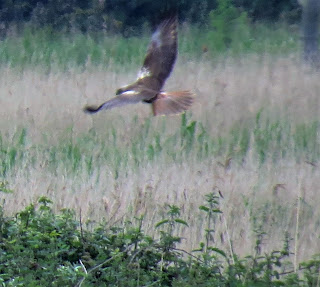 |
| Sedge Warbler |
It has been wet and miserable over the weekend. So I was rather surprised when we arrived to Titchwell this morning in warm sunshine, despite it looking like it was threatening to rain on the ride up to this part of the north Norfolk coastline. We had to take our coats off during our walk as it was so nice. The birds were singing in the reeds and bushes and everywhere you looked, a warbler darted low close to the paths. Sitting on a bench, while waiting for Mum to return from a trip to the toilet block in the car park, I watched several sedge warblers flitting to and fro in the reed beds, as well as reed buntings, reed warblers and the odd Cetti's warbler and bearded tit. A couple of marsh harriers were soaring around the other side of the reserve in the distance and the faint sound of a bittern could be heard, muffled amongst the songs of warblers and screeching gulls.
 |
| Reed Bunting |
 |
| Marsh Harrier |
 |
| Pochard |
 |
| Black-headed Gull |
 |
| Knot murmuration |
As we neared the first pool and the first hide, something caught my eye. It was an amazing murmuration of 2-3,000 knot and other waders. I don't usually see this spectacle this far out from Snettisham, where thousands of these birds weave across the sky as they escape the daily tides of The Wash. But today we were treated to this magnificent display up close in all its glory. That is, until we entered the first hide, when they decided to settle down on the pools for a snooze instead. We had the best seats to see them in action, only to not see them in action. Typical! Still, seeing thousands of these birds crammed together to form their own living islands amongst the mud of the shallow pools was quite a visual treat for the eyes.
 |
| Godwits and Knots |
Looking through my binoculars, it is like looking at a living carpet of grey-brown feathered heads and bodies. I scan through the crowd of sleepy birds like finding where each piece of a jigsaw puzzle, hoping to find the piece that is slightly different to the others. Every few birds in the knot flock turns out to be a different species of wading bird like a godwit or an oystercatcher or an avocet. Away from the mass of birds, there were several ducklings and chicks feeding out on the pools and islands, watched closely by their parents. The avocets especially were over protective for their three tiny fluffy chicks, chasing anything that got near them.
 |
| Knot |
 |
| Avocet |
 |
| Avocet and Shoveler with ducklings |
 |
| Avocet chick |
 |
| Mallard duckling |
 |
| Oystercatcher |
We continued to walk down to the beach, seeing linnets, skylarks, little egrets and a common tern along the way. Crunching over thousands of razor shells on the beach, we reached the shoreline where the tide was coming in. Oystercatchers, dunlins and sanderlings were racing the tideline, pecking for a quick morsel to eat before the tide rushed in and wash their food source away, revealing new ones at the same time with every wave. Just beyond the waves, little terns were diving into the sea to catch small fish. The light at this point made it difficult to locate them through my camera lens. I couldn't get a decent shot of them at all.
 |
| Sanderlings (I think) |
 |
| Little Tern |
 |
| Linnet |
 |
| Little Egret |
 |
| Meadow Pipit |
 |
| Common Blue Butterfly |
 |
| Robin |
After walking back to the visitor centre, we had a picnic at one of the tables in the picnic area. We weren't the only ones having our lunch here as two robins and a jay joined us. We gave them a few crumbs of cake, which they happily came to either on our table or on the ground beside us to carry them away.
 |
| Jay |
 |
| Cuckoo |
After lunch, we had enough energy for one more walk. We decided to walk to the East Trail to try and find lesser whitethroats that had been reported shortly after our first walk. As we were making our way down there, we came across a crowd of bird watchers by the pond where we saw the redstart the other month. I was curious, so I asked one of them what they were looking at. "Look through here" said a man, pointing at his telescope. I did as I was told and through it was a male cuckoo sitting in a tree! It was really close. You could actually see it without the need of the scope.
 |
| Red-crested Pochard |
We didn't find the lesser whitethroats in the end, but we did see a common whitethroat, a stock dove, crested pochards, marsh harriers and a few other things. We made our way back to the car, finding that the cuckoo was still there by the pond, giving us one last view of it to send us on our way home.
 |
| Song Thrush |
 |
| Stock Dove |
















































































No comments:
Post a Comment